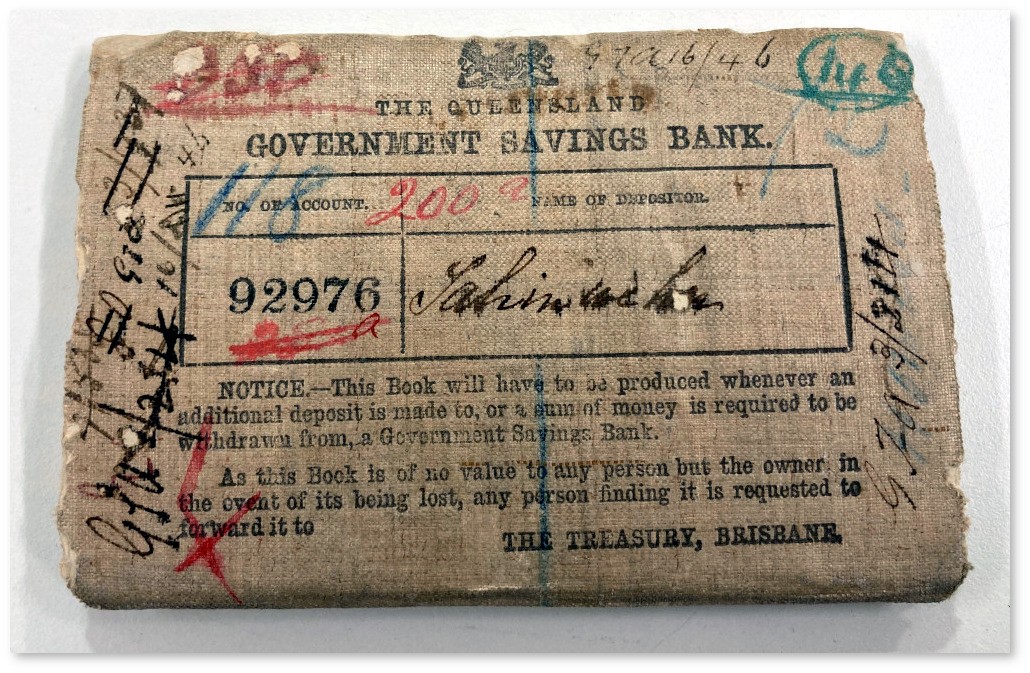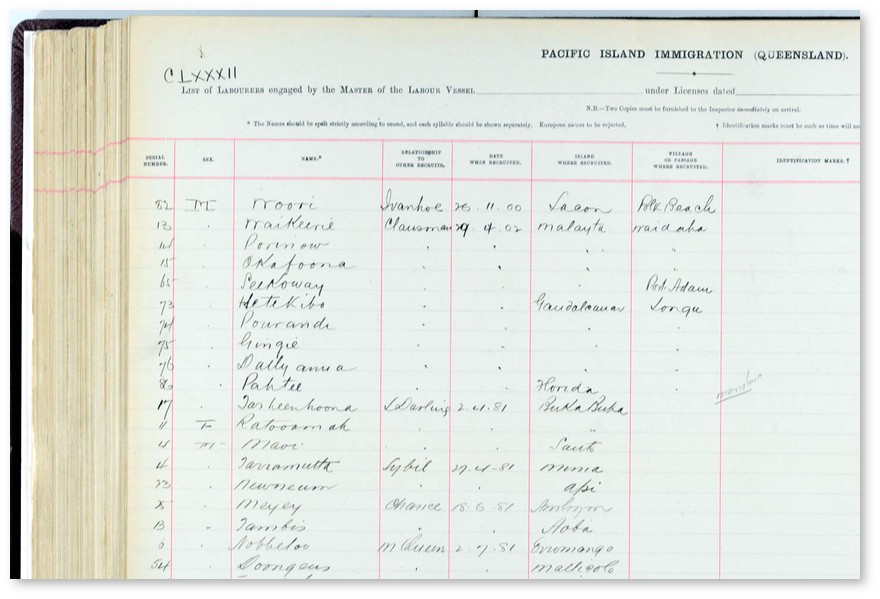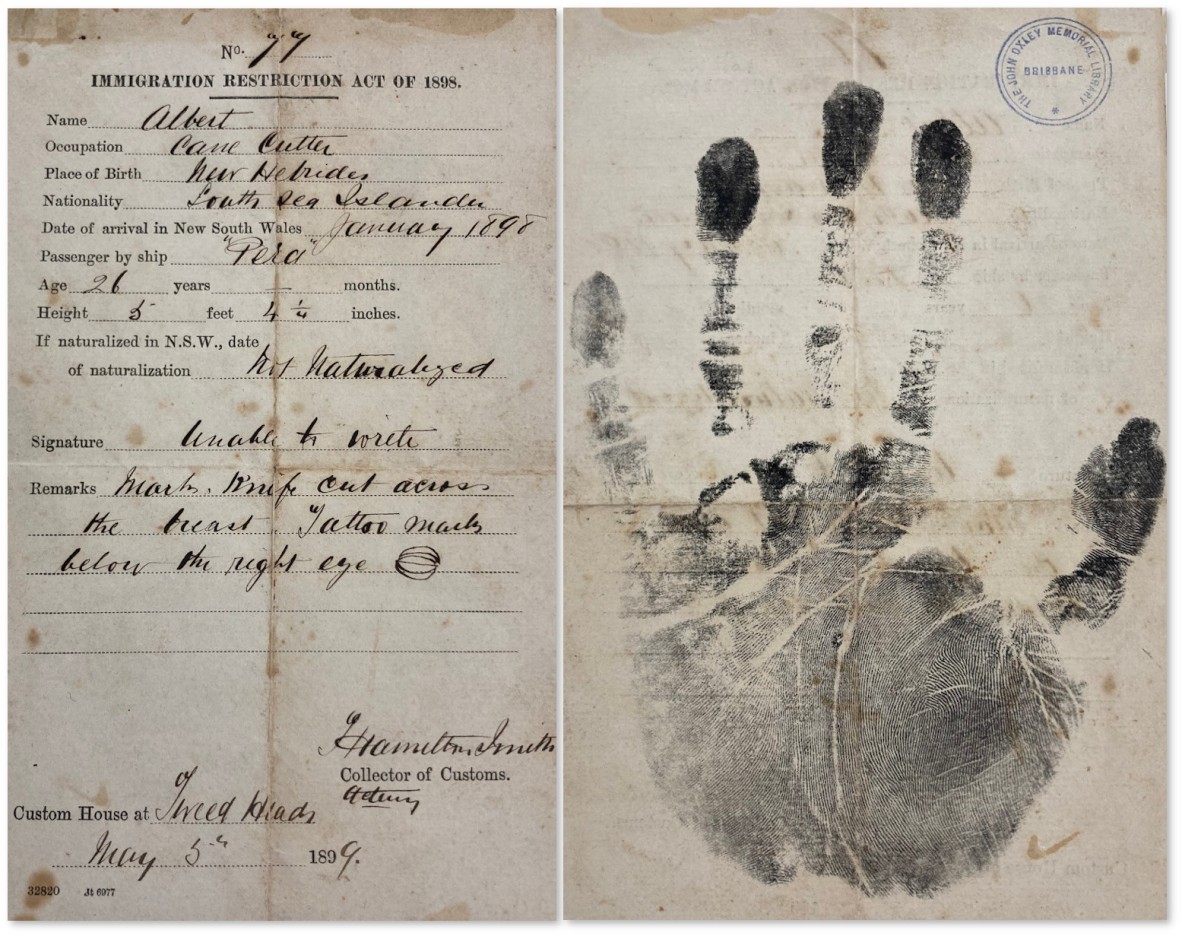Sugar slaves
By Marg Powell, Specialist Library Technician, Metadata Services | 15 April 2021
Another side of Queensland's history - South Sea Islander labour - and the 'boats that stole our people'.
Blackbirding was a term used by Europeans to soften its real meaning, and in the language of those families who still seek their loved-ones - it refers to the 'boats that steal people' - slave traders who enticed South Sea Islanders to board their ships and take them to a land where they were enslaved on plantations far from their homelands, many died, some were returned, others never saw their families again, remaining in Queensland to eek out a living in a predominantly white society.
Tucked away in an envelope held at the John Oxley Library and marked 'Kanaka papers' are powerful reminders of the estimated 62,000 'sugar-slaves' brought to Queensland between 1863 and 1904. The envelope houses just two items - without provenance - first catalogued in the 1970s - now it is time to release them into a globally connected community - and together we might be able to reveal their stories …
Item 1. Savings pass book

Savings pass book, Takin-we-ha, 1883-1920 (OM79-17/28 State Library of Queensland collection)
This item was issued to Takin-we-ha [or Takin we her / Tar Heenweher] and is dated 1883. A note on the inside flap records that he arrived on the schooner 'Madeline' from Buka Buka, 31 August 1882. It also notes that he has a scar upon his right temple and a wheel tattooed on his left forearm.
The 'Madeline' was commanded by Captain Henry William Wigmore (1846–1889), and left Brisbane on 10 May 1882 bound for Vanuatu, arriving 10 days later, on board was government-appointed agent James McMillan. On this voyage they 'recruited' labour from Sandwich [Efate], Mona, Mia, Lopivi, Ambrym, Apil, Malicolo, Aoba, Santo, Book-Booka [Buka Buka], Lavu and Ureparapara Islands. The schooner (or slaver) entered Moreton Bay, 28 August 1882 with 102 'recruits' onboard.
Under the 'Polynesian Labourers Act 1868 (Qld)' recruited labour was indentured for three years in exchange for a small wage of £6 per year as well as rations, accommodation and clothing. Employers were required to deposit their employees wages into a Government Savings Bank account.
J.W.C. Howard, a plantation owner in Coomera, opened this account.
Takin-we-ha worked in the southern Queensland region of Coomera and remained employed for almost 40 years, when the entries in the passbook are discontinued.
A small note on the inside the flap of the savings book states:
"This boy brother is Ta-veen-hoora [possibly Tarheenhoona] Ex L. Darling, [schooner, Lady Darling] 2.4.81. Bk Book 127964. This boy asked me to insert this. W.M. 17.2.92"

Ta-veen-hoora's name is recorded in a 'List of Pacific Island Labourers in Queensland', held at the Queensland State Archives
It confirms that he too was from Buka Buka and arrived the previous year in April 1881 having been 'recruited' via the 'Lady Darling'.
This ship commanded by Captain McDougall, came into difficulties during the voyage on a reef off Malicolo [Maliola] - all hands and 23 recruits were rescued by the 'Lady Belmore' commanded by Captain Currie, and arrived off Woody Island, Port Douglas, 26 March 1881.
It is easy to speculate that the two brothers sought each other out and were reunited, and perhaps that was the case. Ta-veen-hoora was still in Queensland when the note was written in 1892.
'Time expired' Islanders moved between districts to obtain work, many settled in the Gold Coast and Logan areas where they started families, the descendants of who remain to this day.
Item 2. Immigration paper

Immigration form, issued for 'Albert' 5 May 1889 front and rear view (OM79-17/28 State Library of Queensland collection)
There is much to be learned from the statements recorded on this document, but attempts in tracking down further details has brought limited success. Whoever 'Albert' really was he also came from Vanuatu, arriving aboard the 'Para' [incorrectly recorded as Pera] first landing in NSW in January 1898, the ship was a known 'slaver' and bluntly states 'unable to write'. The customs officer at Tweed Heads also noted his identifying marks - a knife cut across the breast, and tattoo marks below his right eye.
Clearly these two items relate to different men. Takin-we-ha and perhaps his brother Ta-veen-hoora remained in Queensland after the mass deportation of South Sea Islanders in 1901 and the introduction of the White Australia Policy. Those who had married or had lived in Australia for 20 years or more were allowed to remain.
But what became of 'Albert' ? Was he returned to his home land or did he make a life for himself in the Tweed …
Read more ...
- The Australian South Sea Islander Story of the Gold Cost Region
- Exhibitions: Australian South Sea Islanders
- Plantation Voices [exhibition and portal]
- Research Guide to Australian South Sea Islander records at Queensland State Archives
- Queensland State Archives, Register of Agreements ID ITM18876 1894-1905
- Sugaropolis: The Mackay-Pacific Island People Trade Voyage Statistics, 1867-1903 by Clive Moore, University of Queensland, 2020
Listen ...
- Vanuatu's stolen generation. Earshot. ABC Radio National, interview by Fiona Pepper, 2020 [28min 36sec]
Watch ...
- Sugar Slaves; Australian South Sea Islanders are descendants of the Pacific Islands Blackbird trade [youtube, 56min 15sec]
View the collection ...
Comments
Your email address will not be published.
We welcome relevant, respectful comments.